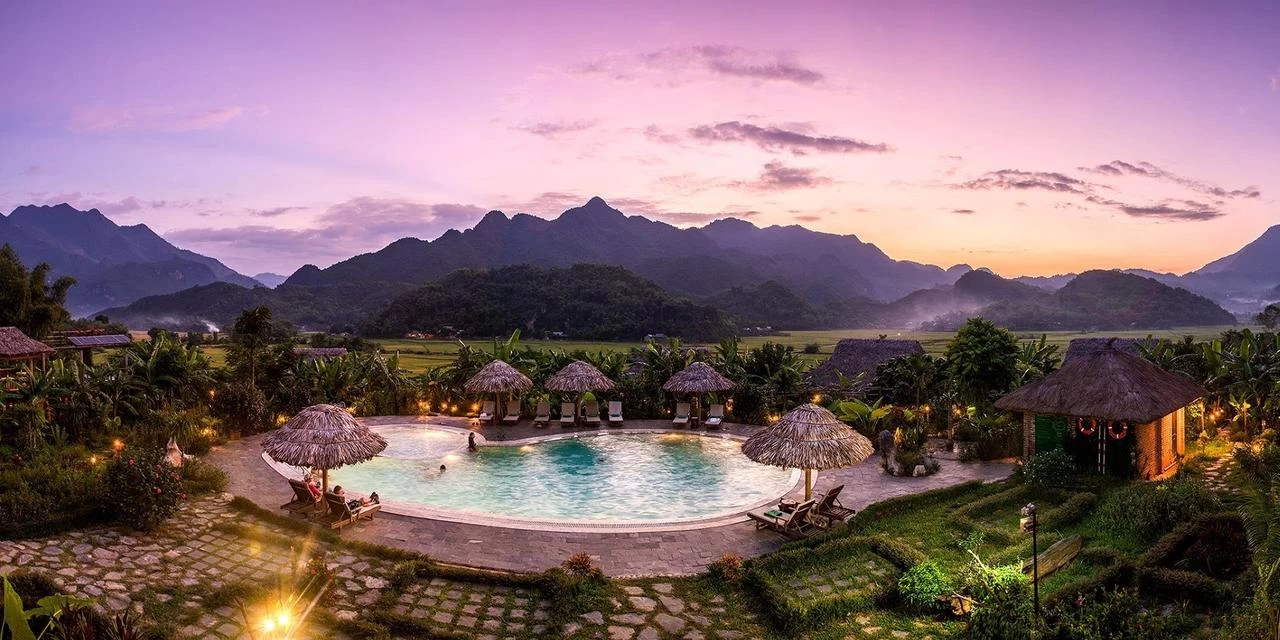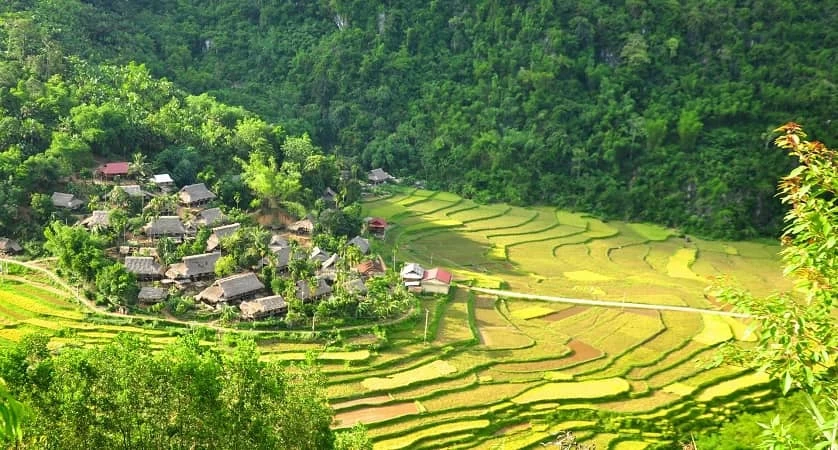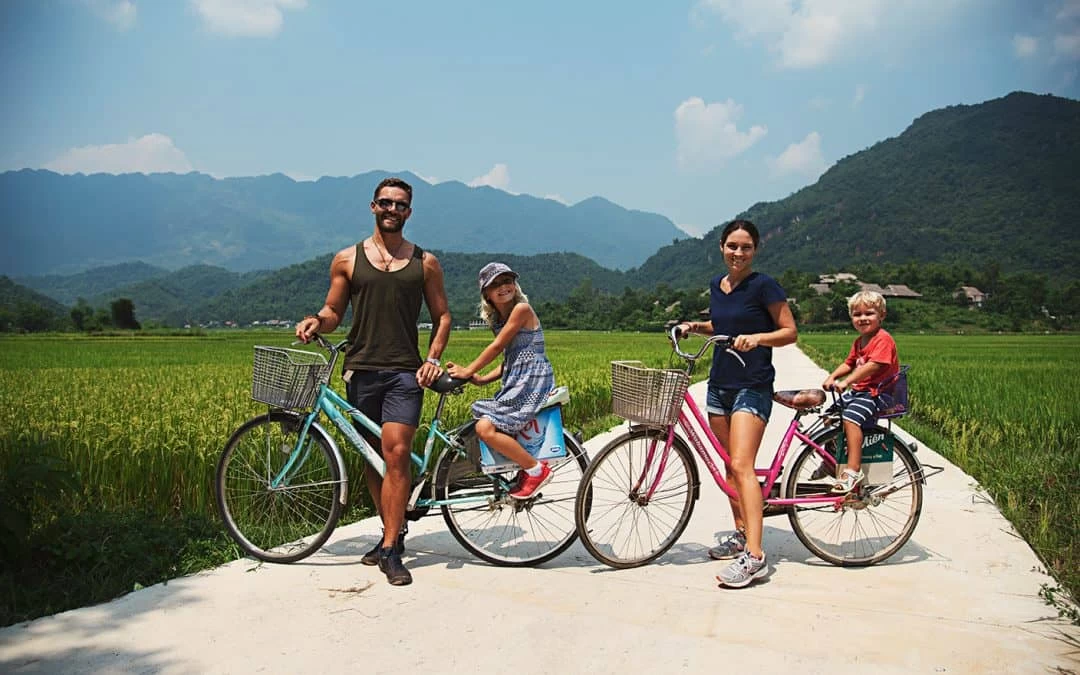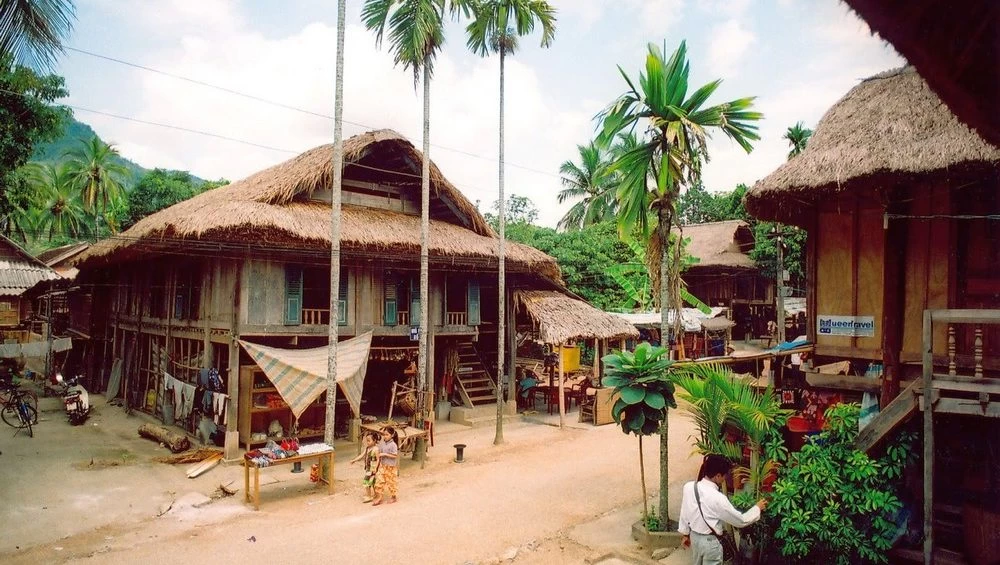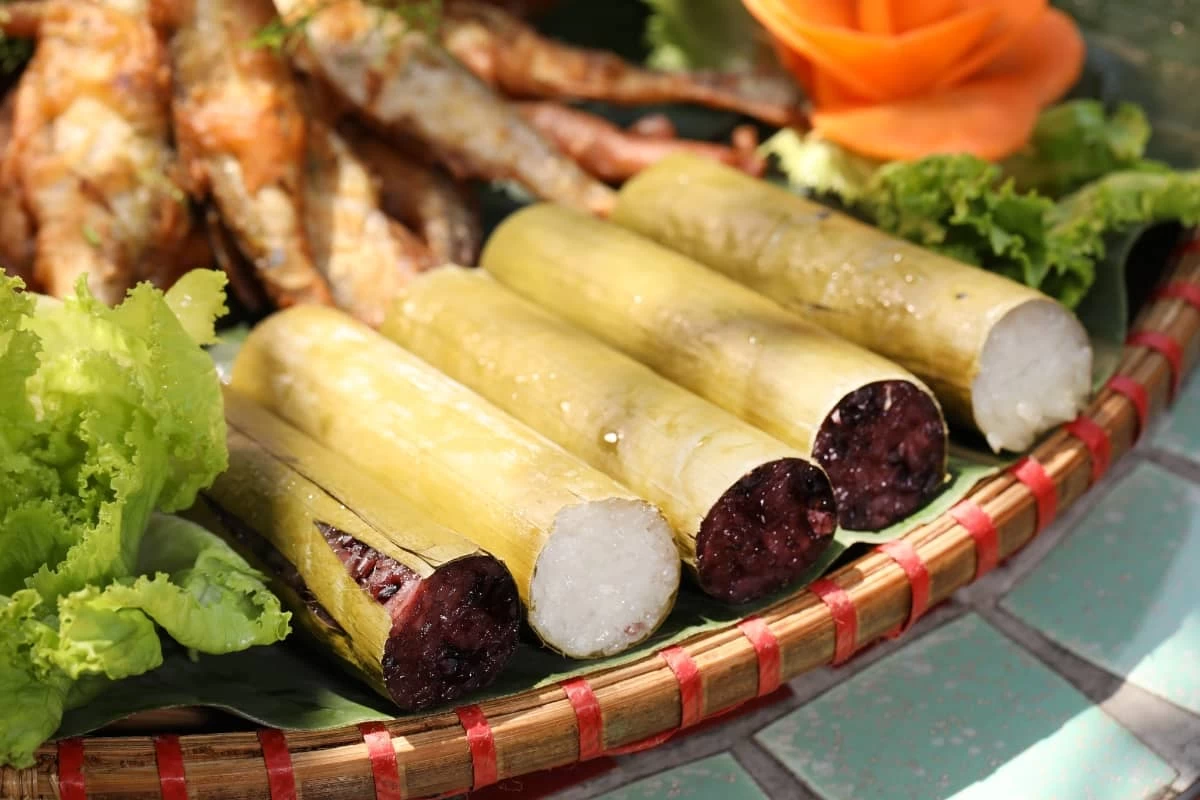
Let’s learn about the unique culture associated with the stilt houses in Mai Chau.
Discover the unique culture of stilt houses in Mai Chau, where traditional architecture meets the vibrant heritage of the local Thai and Muong people. Learn about the history, daily life, and customs within these elevated homes, and immerse yourself in an authentic homestay experience. Find travel tips and insights on preserving this cultural treasure in the heart of northern Vietnam. Follow Ula Travel now!
I. Introduction
1. Overview of Mai Chau
Mai Chau, a picturesque valley located in the northern mountainous region of Vietnam, is renowned for its breathtaking landscapes and the rich cultural heritage of its ethnic minority groups.

Mai Chau is home to many ethnic minorities.
Nestled among lush green rice paddies and towering limestone mountains, this tranquil destination is home to the White Thai, Hmong, and other ethnic communities who have preserved their traditional way of life for generations.
One of the most distinctive cultural symbols of Mai Chau is the stilt house, a unique architectural structure that reflects the deep connection between the people and their natural surroundings.
2. Ethnic People Place Great Significance on Stilt Houses in Their Lives.
Stilt houses play an essential role in the daily lives and cultural identity of the local ethnic groups, particularly the White Thai and Muong people. These elevated wooden homes are not merely a form of shelter but also serve as a representation of their cultural values, social structures, and harmonious relationship with nature.

Stilt houses are a part of the lives of ethnic minorities.
The stilt houses offer protection from floods and wild animals and provide a cool, airy living environment, making them both practical and symbolic in the local community. Beyond their functionality, these homes are a gathering space for family and social activities, often used for important ceremonies, communal events, and traditional rituals. As such, the stilt houses in Mai Chau are a living testament to the enduring customs and resilient spirit of the region’s indigenous peoples.
II. Architectural Features of Stilt Houses in Mai Chau
The stilt houses in Mai Chau reflect a deep connection between the local people and their natural environment, with their design and materials perfectly adapted to the region’s terrain and climate. The construction of these houses is a harmonious blend of practicality and tradition.
1. Natural Materials
Stilt houses are predominantly built using natural, locally sourced materials such as wood, bamboo, and palm leaves. The wooden pillars and beams form the structural foundation, ensuring durability and resilience.

The stilt houses in Mai Chau are usually made of wood.
Bamboo, which is plentiful in the area, is often used for flooring, walls, and railings due to its flexibility and strength. Palm leaves or other natural fibers are traditionally used for roofing, offering effective insulation and ventilation. These materials not only provide a sustainable option but also allow the house to blend seamlessly into the surrounding landscape.
2. Elevated Design for Protection

The stilt houses are all designed high above the ground.
One of the most distinctive architectural features of these houses is their elevation on wooden stilts, typically 1.5 to 2 meters above the ground. This elevated structure serves multiple purposes. Firstly, it protects the inhabitants from seasonal flooding, a common occurrence in the region. Secondly, it offers improved ventilation, allowing cool air to circulate underneath the house, which is essential in the hot and humid climate. The height also keeps the house safe from wild animals, a feature especially important in the past when forests were more densely populated.
3. Sloped Roof and Weather Resistance

The roof is made from natural materials suitable for the climate.
The sloped roof design is another key feature of stilt houses in Mai Chau. Typically made from thatch or palm leaves, the roof is designed to be steep, enabling rainwater to flow off quickly and preventing water from accumulating. This is crucial in the region’s tropical climate, where heavy rains are common during the monsoon season. The sloped roof also helps in regulating the house’s temperature, providing shade, and protecting the interior from direct sunlight.
4. Interior Layout
Inside a typical stilt house, the space is divided into communal and private areas, all designed to accommodate the needs of an extended family. The main room, usually the largest, serves as a communal space where family members gather, eat, and socialize. This room often has an open layout, allowing flexibility for various activities such as meetings, celebrations, or traditional ceremonies.

Every stilt house has a very large and airy common living space.
Adjoining this central space are smaller, more private rooms used as sleeping quarters, with bamboo or wooden partitions providing privacy. Furniture is minimal, often limited to bamboo mats or low wooden tables, which complement the house’s simple yet functional aesthetic.
Additionally, the raised floor provides storage space beneath the house, where livestock or farming tools can be kept, ensuring they remain dry and safe during the rainy season. This thoughtful use of space reflects the resourcefulness of the local communities, maximizing functionality while preserving cultural traditions.
III. Stilt Houses in the Daily Life of Ethnic People
1. Everyday Activities in Stilt Houses
Stilt houses in Mai Chau serve as the heart of daily life for ethnic communities, particularly the Thai and Muong people. These elevated structures are much more than just living quarters; they are the setting for most household activities and social interactions.

Many cultural activities take place in the space of the stilt house.
Inside the house, family members gather for meals, share stories, and conduct daily chores such as weaving, cooking, and crafting traditional items. The open space beneath the house is often used for storage or sheltering livestock, while also acting as a communal area where neighbors can meet, chat, and bond.
During the day, women might be seen weaving fabrics on traditional looms, an activity passed down through generations, while men engage in farming or craftsmanship. Evenings bring family members together for meals around a communal pot, with everyone sitting on woven mats, creating a close-knit atmosphere of warmth and connection.
Start your journey with: Hanoi to Mai Chau Tour 3D2N
2. Traditional Rituals and Customs
Stilt houses are also the stage for important rituals and ceremonies that are integral to ethnic cultural life. Weddings, for instance, are often held in the main room of the house, with elaborate preparations involving the entire family and community. Traditional wedding ceremonies, complete with specific rites and offerings, take place under the roof of these homes, symbolizing the joining of two families in a meaningful way.

Ethnic minority wedding ceremony.
Another significant custom is ancestor worship, which is usually performed inside the house. An altar dedicated to the family’s ancestors is placed in a prominent part of the home, typically in the central room. On special occasions, such as Lunar New Year or local festivals, offerings of food, incense, and prayers are made to honor the spirits of ancestors, seeking blessings and protection for the family.
More details: Impressive Mai Chau Tour
3. Social Role of Stilt Houses
Stilt houses are more than just architectural structures; they are powerful symbols of ethnic identity and social cohesion. The design and layout of these homes reflect the values of community living and mutual support. For example, the large communal spaces inside the house allow for gatherings where decisions affecting the village can be discussed, reflecting the importance of collective responsibility.

Many community meetings take place in the communal living space of the stilt house.
Moreover, stilt houses serve as a representation of cultural continuity. They are not just homes but symbols of the ethnic group’s history, customs, and way of life. When visitors or tourists step inside a stilt house, they are stepping into a space that embodies the ethnic group’s unity, traditions, and social bonds. These homes foster a sense of belonging and pride among the people who live in them, making them vital to maintaining the cultural fabric of ethnic communities in Mai Chau.
Are you looking for Best Mai Chau to Pu Luong Trekking Tour 4D3N?
IV. Experience of Staying in a Stilt House in Mai Chau
One of the most immersive ways to experience the unique culture of Mai Chau is by staying in a traditional stilt house through a local homestay. This allows international tourists to connect deeply with the authentic lifestyle of the ethnic minority groups, primarily the White Thai people, who have called this region home for generations.
1. Authentic Homestay Experience
A stay in a stilt house offers much more than just accommodation; it is an invitation into the daily lives of the local people. These homes, typically raised on wooden stilts, are built using natural materials like bamboo and thatch and feature spacious communal living areas where families gather and interact. Guests are often welcomed warmly, with hosts eager to share their way of life, from meal preparation to evening storytelling.

Tourists experience local life.
Tourists sleep on the upper level of the stilt house, where traditional woven mats and soft bedding are laid out. The lower part of the house is generally used for livestock or storage, but staying upstairs gives a sense of both protection and openness as you enjoy stunning views of the surrounding rice fields and mountains. Without modern hotel luxuries, the simplicity of stilt houses offers a back-to-basics charm, enhancing the connection with nature and the community.
Read more: Things to do in Mai Chau
2. Cultural and Community Activities
During your stay, many homestays offer opportunities to engage in local traditions and activities, enriching the cultural exchange. You might start your day by participating in traditional weaving, where local artisans teach you the intricate methods of creating beautiful textiles using looms passed down through generations. These handcrafted products, often colorful and symbolic, are an important part of ethnic identity in Mai Chau.

Xeo Dance
In the evening, you can enjoy cultural performances, where local villagers showcase their traditional dances and music, often performed around a central bonfire. The Xoe dance, a symbolic dance of the Thai people, is particularly popular, and guests are encouraged to participate, moving in harmony with the rhythmic beats of gongs and drums. Sharing in these cultural performances is a unique way to break down barriers, fostering a sense of unity between visitors and hosts.
Click here: All Mai Chau Tours
V. Traditional Crafts and Cuisine Associated with Stilt Houses in Mai Chau
In Mai Chau, the traditional stilt houses are not only a representation of the unique architectural style of the region but also serve as a hub for preserving the rich cultural heritage of the ethnic communities living there. One of the most prominent aspects of this heritage is the traditional crafts and cuisine closely linked to the daily life and customs of the locals.
1. Traditional Crafts
The residents of Mai Chau, particularly the Thai and Muong ethnic groups, are renowned for their exceptional skills in traditional weaving. Weaving is more than just a craft; it is a cultural symbol passed down through generations, reflecting the artistry and history of the region.
Inside the stilt houses, visitors can often witness the women of the community sitting by wooden looms, meticulously weaving colorful fabrics. These handwoven textiles, known as “tho cam,” are crafted from natural fibers like cotton and silk and often adorned with intricate patterns that hold symbolic meanings. These patterns represent various elements of nature and life, including rivers, mountains, and even spiritual beliefs.

Tourists visit weaving village in Mai Chau
Apart from weaving, Mai Chau is also known for its traditional crafts, including bamboo and rattan products. Locals skillfully craft baskets, mats, and other household items, many of which are both functional and decorative.
These items are typically made from materials sourced from the surrounding environment, maintaining a strong connection between the people and the land. Tourists often have the opportunity to purchase these handcrafted items as souvenirs or even participate in the process of making them during their stay in stilt house homestays.
You might be like: Mai Chau Day Trip from Hanoi
2. Local Cuisine
The cuisine associated with the stilt houses in Mai Chau reflects the simplicity and natural abundance of the region. Meals are typically prepared with fresh, locally sourced ingredients, and many dishes are deeply rooted in the traditions of the ethnic communities.
Among the most iconic dishes is “com lam”—a type of sticky rice cooked in bamboo tubes. This dish is a culinary representation of life in the mountains, where bamboo is plentiful. The rice is infused with the subtle flavor of bamboo, giving it a unique aroma and taste that is highly appreciated by visitors.

The culture of drinking Can wine in Mai Chau.
Another must-try dish is grilled pork with macma leaves. Mac mat is a type of wild forest leaf that imparts a sweet and slightly sour flavor to the meat, creating a delightful contrast that pairs well with the natural sweetness of the pork. This dish is often served during community gatherings or festivals and is a staple of Mai Chau’s hospitality.
No traditional meal in Mai Chau would be complete without a taste of ruou can, a fermented rice wine traditionally drunk through long bamboo straws from a communal jar. This beverage is an integral part of local ceremonies and celebrations, symbolizing unity and togetherness. Ruou can is typically enjoyed in a social setting, with friends and family gathered around, sharing stories and experiences.
Learn more about: Mai Chau Cuisine
VI. Travel Tips for Visiting Mai Chau Stilt Houses
1. Best Time to Visit Mai Chau
The best time to visit Mai Chau depends on the type of experience you’re looking for.
- From March to May and September to November are ideal for international travelers due to the pleasant weather. During these months, temperatures are mild, and the rice fields are particularly scenic—lush green in spring and golden in autumn.
- The winter months (December to February) can be colder, but it’s a perfect time if you prefer fewer tourists and a serene atmosphere.
- If you’re interested in cultural festivals, April and August coincide with some of the traditional festivals held by the local ethnic groups, offering a deeper cultural experience.
2. Must-Do Activities
- Trekking and Cycling: Exploring Mai Chau’s beautiful landscapes on foot or by bike is an unforgettable experience. The valley is filled with lush rice paddies, rolling hills, and small villages where you can witness daily life in its most authentic form. Popular trekking routes include visiting Pom Coong, Ban Lac, and Na Phonvillages, which offer a mix of scenic views and cultural interactions with the local ethnic groups.
- Craft Workshops and Cultural Performances: Many homestays offer hands-on workshops where you can learn traditional weaving techniques or try your hand at making local crafts. In the evenings, some host families organize Thai traditional dance performances where you can join in, dressed in traditional attire, and enjoy the lively atmosphere with locals.
In conclusion, the stilt houses of Mai Chau are a vital part of the region’s cultural heritage, offering insight into the daily lives and traditions of local ethnic communities. For international travelers seeking an authentic cultural experience, staying in a stilt house offers a unique opportunity to immerse in the rhythm of local life, interact with hospitable villagers, and appreciate the simplicity and beauty of Mai Chau’s rural charm.
See more: Mai Chau Travel Tips



